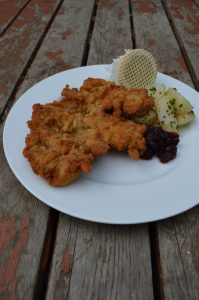
Subtitle: The Subtle Art of Hitting Meat with a Hammer
Long before I knew anything about European cuisine, I was familiar with the term Wiener Schnitzel. Well, sort of. My mom baked us frozen “Wiener schnitzel” from M & M Meat Shop every once in a while. But I didn’t know that Wiener means “from Wien”, or that Wien is the actual name of the city English-speakers call Vienna. I also didn’t know that “schnitzel” is related to the word schnitte, which means “slice.” Wiener Schnitzel is a piece of veal, traditionally from the leg, pounded out with a mallet, breaded, and fried.
I love veal, but I almost never have it in my house. It’s hard to come by in Alberta, and expensive. This is kind of strange, as we have a large dairy industry, and in famous dairy regions like Switzerland veal is an obvious and necessary corollary to milk production. Luckily, in Austria any and all proteins can be found malleted and fried to make schnitzel. I had, for instance, turkey schnitzel and lamb schnitzel while I was there. The term “Wiener” is however reserved for the veal version.
At home I most often make pork schnitzel. While many online sources suggest using loin, the schnitzel technique is much better suited to cuts from the leg, which benefit from the tenderization of the malleting.
Pork leg will work best if is has been separated into its component parts in the Austrian style (described in this post). This way you have cohesive muscle groups that are the perfect size for schnitzel and hold their shape during malleting.
The four sections of the pork leg are Kaiserteil (inside round), Frikandeau (outside round), Nuß (sirloin tip), and Schlussbraten (sirloin). All of these sections work well, but for my money the inside round is the best. It spreads the easiest and the most uniformly. The outside round is a bit resistant to spreading; you really have to beat the hell out of it. The sirloin had a tendency to separate into its individual muscles.
Makes sure to slice across the grain of these muscles.
Malleting
Folding a bit of plastic wrap around the meat will help it spread without tearing.
Breading
I worked in at least one kitchen in Austria in which the schnitzel was malleted and breaded to order, but I think it is best to bread early and give the crust time to hydrate and adhere to the meat. If you bread at the last minute the crust will pull away from the meat in large bubbles and folds.
Schnitzel is made with a standard breading procedure. First dredge the cutlet in flour. The flour is only to dry the surface of the meat so that later the egg will adhere better. Dredge thoroughly so that every crack and corner has been floured, but then shake off all excess flour so that there is a superthin, uniform layer.
Next drop the floured cutlet into whisked eggs. As before, try to get total coverage, but then gently shake excess egg from the surface.
Finally press the meat into bread crumbs to get them stuck absolutely everywhere.
Frying
Nowadays in restaurants schnitzel is usually deep-fried, but traditionally it is shallow-fried in a pan. The Austrians say that there should be enough oil in the pan so that the schnitzel is “swimming.” Too little oil and the irregular, breaded surface will not brown evenly.
The oil should bubble vigorously when the schnitzel first take their dive.
If you are frying schnitzel in more than a couple of batches, you should strain the oil between batches. Bits of breadcrumb will fall off and blacken, then stick to other schnitzels and make them look burnt.
Accompaniments
The traditional accompaniment to Wiener schnitzel is Petersilienkartoffeln, which is boiled, parsley’d potatoes. This is dogma. I remember eating dinner at a brew pub in Vienna with my sister. She wanted schnitzel, but was also eager to try spätzle. She asked if she could substitute the parsley potatoes for the tiny dumplings. The waiter looked at here plainly and said no. Schnitzel must be served with parsley potatoes. And for the record, spätzle is only served with braises and stews.
At home I like serving it with Gemischtersalat, which is a combination of a few different salads like potato salad, marinated tomato, cabbage, and the like.
The other traditional accompaniments in Vienna are cranberry compote and a lemon wedge for the dinner to squeeze onto the meat. One of the single most luxurious and elegant things I’ve ever seen in a restaurant was on the schnitzel plate served at Landtmann’s in Vienna. The dish came with half a lemon that was wrapped in muslin, tied with a bow. When you squeeze the lemon the muslin lets the juice through but keeps back the seeds. So fancy.
Other common variations are Jaegerschnitzel, or hunter’s schnitzel, served with wild mushrooms like chanterelles, and Schnitzel Holstein, served with a fried egg, caper, anchovy, and lemon.